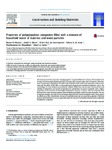Use este identificador para citar ou linkar para este item:
http://www.alice.cnptia.embrapa.br/alice/handle/doc/984323Registro completo de metadados
| Campo DC | Valor | Idioma |
|---|---|---|
| dc.contributor.author | MATTOS, B. D. | pt_BR |
| dc.contributor.author | MISSIO, A. L. | pt_BR |
| dc.contributor.author | CADEMARTORI, P. H. G. de | pt_BR |
| dc.contributor.author | LIMA, E. A. de | pt_BR |
| dc.contributor.author | MAGALHAES, W. L. E. | pt_BR |
| dc.contributor.author | GATTO, D. A. | pt_BR |
| dc.date.accessioned | 2016-02-29T19:40:14Z | - |
| dc.date.available | 2016-02-29T19:40:14Z | - |
| dc.date.created | 2014-04-10 | pt_BR |
| dc.date.issued | 2014 | pt_BR |
| dc.identifier.citation | Construction and Building Materials, v. 61, p. 60-68, 2014. | pt_BR |
| dc.identifier.uri | http://www.alice.cnptia.embrapa.br/alice/handle/doc/984323 | pt_BR |
| dc.description | This study presents the preparation of polypropylene composites filled with mixtures of household waste of mate-tea and eucalypt particles and aims to increase the economic value chain of mate-tea. Filler mix- tures in proportions ranging from 0% to 60% with a fixed PP matrix at 40% were prepared in order to eval- uate only the effect of the filler on thermochemical, physical and mechanical properties and on the morphology. The main findings showed that the addition of filler from natural sources decreased thermal stability of composites, but that the temperature of crystallisation increased. Composites with a higher proportion of wood particles showed higher hydrophobic character; however, only the composites with 60% and 54% of mate-tea waste particles showed significantly higher results for water absorption. The use of eucalypt particles increased more mechanical properties than that of household waste, which proves its efficiency as filler. Nevertheless, the use of household waste also increased the properties of the final product and showed that it can be a good alternative for the use of renewable materials in the production of polymeric composites. | pt_BR |
| dc.language.iso | eng | eng |
| dc.rights | openAccess | eng |
| dc.subject | Erva mate | pt_BR |
| dc.subject | Compósito | pt_BR |
| dc.subject | Polímero | pt_BR |
| dc.subject | Flat-pressed composite | pt_BR |
| dc.subject | Polymer-matrix composite | pt_BR |
| dc.subject | Fast-growing eucalypt | pt_BR |
| dc.title | Properties of polypropylene composites filled with a mixture of household waste of mate-tea and wood particles. | pt_BR |
| dc.type | Artigo de periódico | pt_BR |
| dc.date.updated | 2016-02-29T19:40:14Z | pt_BR |
| dc.subject.thesagro | Ilex Paraguariensis | pt_BR |
| dc.subject.thesagro | Resíduo | pt_BR |
| riaa.ainfo.id | 984323 | pt_BR |
| riaa.ainfo.lastupdate | 2014-04-10 | pt_BR |
| dc.identifier.doi | http://dx.doi.org/10.1016/j.conbuildmat.2014.02.022 | pt_BR |
| dc.contributor.institution | Bruno D. Mattos, Faculty of Materials Engineering (PPGCEM), Federal University of Pelotas; André L. Misso, Forestry Engineering (PPGEF), Forest Products Laboratory, Centre for Rural Sciences, Federal University of Santa Maria; Pedro H. G. de Cademartori, Wood and Forestry Science Centre (PPGEF), Federal University of Paraná; EDSON ALVES DE LIMA, CNPF; WASHINGTON LUIZ ESTEVES MAGALHAES, CNPF; Darci A. Gatto, Federal University of Pelotas and Federal University of Santa Maria. | pt_BR |
| Aparece nas coleções: | Artigo em periódico indexado (CNPF)  | |
Arquivos associados a este item:
| Arquivo | Descrição | Tamanho | Formato | |
|---|---|---|---|---|
| 2014APIPropertiesPolypropilene.pdf | 2.03 MB | Adobe PDF |  Visualizar/Abrir |









